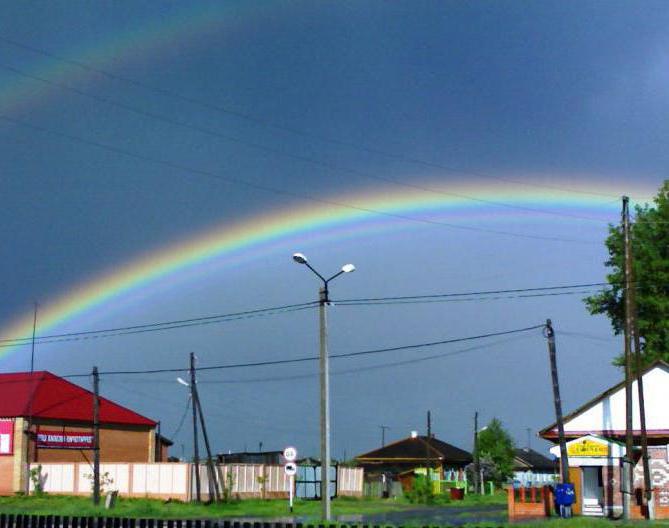Vagay (northern): where is the history of education
In the Tyumen region, two villages are called Vagai. One of them is in the Omutinsky district, the second, located to the north, is the center of the Vagai district. Most recently, residents of the Siberian village of Vagay (northern) celebrated the 395th anniversary of the foundation. Till now it had two names. Initially, at the base, the village bore the name Bogoslovskoe, later it became known as the Vagayskoe, since it was located near the Vagai River, which flows into the Irtysh.

Where is
At a distance of 5 kilometers from the village of Vagay(northern) Vagaysky district of the Tyumen region is the place where the same river flows into the Irtysh. The Vagai River is its left tributary. And at the river there are 2 estuaries. The first is natural. The second - man-made, dug in 1960 for the convenience of rafting wood.
At the mouth of the Vagay River there is Ermakova creek. Historians suggest that Ermak died here. The village itself is located in the south of the Tyumen region. At a distance of 55 kilometers down the Irtysh River, the city of Tobolsk is located. It borders on the regions of the Tyumen and Omsk regions.

Prehistory
In Siberia, when it was settled, there was an iron rule,which is always adhered to: "With each capture - prayer cross, with the village - the church, with the city - the monastery." This was done with one goal - to strengthen the faith, to support the morally Orthodox Christians who go to unknown lands. Often in military detachments were clergymen. In each newly built settlement the first thing was built a small wooden church. This was originally built in the village of Bogoslovsky (modern Vagay, northern).
The Orthodox Church, first of all, baked aboutsouls of the Orthodox. They fled here from serfdom, convicts said. As it was said, passing through the mountains of the Urals, the Moscow authorities ended and the "free will" began, in which Christian shrines were often trampled. There were murders, polygamy and other serious sins. In addition, the Orthodox Church had missionary goals - to turn to Christ thousands of pagans, who were local residents. Often the servicemen and even the voevods were not a model for imitation. The absence of churches led to a decline in morality.
The first in Siberia Assumption Monastery, locatedunder the protection of the Tobolsk Kremlin, receives in 1612 huge land allotments in the Irtysh Valley, including those located on both sides of the Vagay River. The earth began to be mastered, and already in 1623 a message appeared about the Vagay monastic estate. There were 5 monastic yards, including in the place of modern Vagaya (northern).

History of rural education
The history of the village of Vagay is closely connected with the historythe development of Russian explorers of Siberia. The main stream of Cossack detachments, settlers, merchants went deep into the edge along the mighty Siberian river Irtysh. The capital of Siberia in those days was the city of Tobolsk. The Bogoslovskoye village, modern Vagay, was located not far from the confluence of the Vagai River in Irtysh and was originally part of the monastic lands. Vagay (northern) was formed as a monastery courtyard of the Assumption, later the Znamensky Monastery.
In the "Landmark Book of the Sophia Estates", dated1659 year, it is written that the village of Bogoslovskoye surrounded by pillars, near the gate - the tower. Inside the fence is the Church of St. John the Evangelist, the cells of two elders and an immigrant. Still beyond the fence are stables and cattle yards, where workers live. It was the church that gave the name to the village - Bogoslovskoye. After that it began to be called Vagaysky.
The village grew slowly, in almost 300 years the populationincreased from 28 people, according to the monastic census of 1659, to 264 people in 1926. The population was engaged in the cultivation of livestock, plowed the land for rye and oats. The main occupation was hunting and fishing. Crafts were also developed, such as carpentry, pottery and blacksmithing.

Soviet years
At the beginning of the twentieth century, the village had two schools,one of which was church-parish. The years of the revolution sharply turned the life of the villagers in the opposite direction. The troubled twenties were replaced by years of collectivization. In the 20s of the last century a feldsher's point was opened, an agricultural and trade association.
In the 30s of the twentieth century clubs were built,schools were opened, not only for children, but also for adults. The country fought with age-old uneducated citizens. New logging enterprises, lekkoopy, and raft raiders were organized. All this touched and sat down.

During the war, the Vagai (northern) Tyumen regionHe was deep in the rear, continuing to supply the country with timber, rye and barley. Hundreds of Vagais went to the front, many of them did not return from the war. In memory of this, a monument is erected on the territory of the village.
Postwar years - this is the time of hard work of allcountry, which needed to restore the city and village. To do this, it was necessary to have a large number of forests supplied by the regions of the Tyumen region. Vagaysky district is mainly oriented to agricultural production and fishing industries, the main one of which was and still is hunting.

How to get there
The village of Vagay is 281 km away fromTyumen. You can get there by shuttle and by train, by watching the train schedule and bus schedule. Vagay (northern) and Tyumen are each from a distance of almost 300 km. To go it is necessary within 5 hours. There are 3 bus trips (10:00, 15:30, and 16:40). They arrive in Vagay on the bus station. From Omsk there are three bus flights. Also transit trains pass through Vagay, electric trains run.








